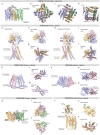Transmembrane proteins with unknown function (TMEMs) as ion channels: electrophysiological properties, structure, and pathophysiological roles
- PMID: 38556553
- PMCID: PMC11059273
- DOI: 10.1038/s12276-024-01206-1
Transmembrane proteins with unknown function (TMEMs) as ion channels: electrophysiological properties, structure, and pathophysiological roles
Abstract
A transmembrane (TMEM) protein with an unknown function is a type of membrane-spanning protein expressed in the plasma membrane or the membranes of intracellular organelles. Recently, several TMEM proteins have been identified as functional ion channels. The structures and functions of these proteins have been extensively studied over the last two decades, starting with TMEM16A (ANO1). In this review, we provide a summary of the electrophysiological properties of known TMEM proteins that function as ion channels, such as TMEM175 (KEL), TMEM206 (PAC), TMEM38 (TRIC), TMEM87A (GolpHCat), TMEM120A (TACAN), TMEM63 (OSCA), TMEM150C (Tentonin3), and TMEM43 (Gapjinc). Additionally, we examine the unique structural features of these channels compared to those of other well-known ion channels. Furthermore, we discuss the diverse physiological roles of these proteins in lysosomal/endosomal/Golgi pH regulation, intracellular Ca2+ regulation, spatial memory, cell migration, adipocyte differentiation, and mechanical pain, as well as their pathophysiological roles in Parkinson's disease, cancer, osteogenesis imperfecta, infantile hypomyelination, cardiomyopathy, and auditory neuropathy spectrum disorder. This review highlights the potential for the discovery of novel ion channels within the TMEM protein family and the development of new therapeutic targets for related channelopathies.
© 2024. The Author(s).
Conflict of interest statement
The authors declare no competing interests.
Figures


Similar articles
-
GolpHCat (TMEM87A), a unique voltage-dependent cation channel in Golgi apparatus, contributes to Golgi-pH maintenance and hippocampus-dependent memory.Nat Commun. 2024 Jul 11;15(1):5830. doi: 10.1038/s41467-024-49297-8. Nat Commun. 2024. PMID: 38992057 Free PMC article.
-
TMEM63 mechanosensitive ion channels: Activation mechanisms, biological functions and human genetic disorders.Biochem Biophys Res Commun. 2023 Nov 26;683:149111. doi: 10.1016/j.bbrc.2023.10.043. Epub 2023 Oct 14. Biochem Biophys Res Commun. 2023. PMID: 37857161 Review.
-
TMEM120A is a coenzyme A-binding membrane protein with structural similarities to ELOVL fatty acid elongase.Elife. 2021 Aug 10;10:e71220. doi: 10.7554/eLife.71220. Elife. 2021. PMID: 34374645 Free PMC article.
-
TMEM120A/TACAN: A putative regulator of ion channels, mechanosensation, and lipid metabolism.Channels (Austin). 2023 Dec;17(1):2237306. doi: 10.1080/19336950.2023.2237306. Channels (Austin). 2023. PMID: 37523628 Free PMC article. Review.
-
TMEM150C/Tentonin3 Is a Regulator of Mechano-gated Ion Channels.Cell Rep. 2018 Apr 17;23(3):701-708. doi: 10.1016/j.celrep.2018.03.094. Cell Rep. 2018. PMID: 29669276 Free PMC article.
Cited by
-
Acute GARP depletion disrupts vesicle transport, leading to severe defects in sorting, secretion, and O-glycosylation.bioRxiv [Preprint]. 2024 Oct 14:2024.10.07.617053. doi: 10.1101/2024.10.07.617053. bioRxiv. 2024. Update in: Traffic. 2025 Jan-Mar;26(1-3):e70003. doi: 10.1111/tra.70003. PMID: 39416116 Free PMC article. Updated. Preprint.
-
The cGAS/STING Pathway: Friend or Foe in Regulating Cardiomyopathy.Cells. 2025 May 25;14(11):778. doi: 10.3390/cells14110778. Cells. 2025. PMID: 40497954 Free PMC article. Review.
-
Systematic proteome-wide Mendelian randomization using the human plasma proteome to identify therapeutic targets for osteomyelitis.Naunyn Schmiedebergs Arch Pharmacol. 2025 Jul 14. doi: 10.1007/s00210-025-04429-9. Online ahead of print. Naunyn Schmiedebergs Arch Pharmacol. 2025. PMID: 40658235
-
Identification of TMEM71 as a hub NLRP3-related gene suppressing malignant behavior in nasopharyngeal carcinoma via the NLRP3/Caspase-1/GSDMD signaling pathway.Braz J Otorhinolaryngol. 2025 May-Jun;91(3):101566. doi: 10.1016/j.bjorl.2025.101566. Epub 2025 Feb 13. Braz J Otorhinolaryngol. 2025. PMID: 39951856 Free PMC article.
-
Acute GARP Depletion Disrupts Vesicle Transport, Leading to Severe Defects in Sorting, Secretion and O-Glycosylation.Traffic. 2025 Jan-Mar;26(1-3):e70003. doi: 10.1111/tra.70003. Traffic. 2025. PMID: 40100055 Free PMC article.
References
Publication types
MeSH terms
Substances
Grants and funding
LinkOut - more resources
Full Text Sources
Molecular Biology Databases
Miscellaneous

